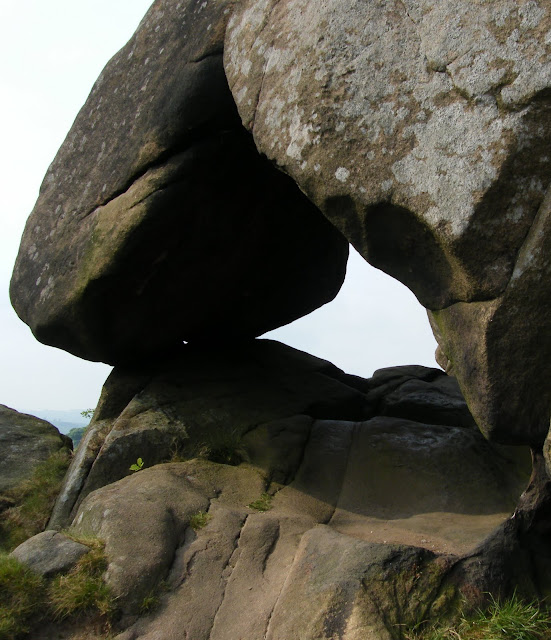Our second trip began with a drive to Arbor Low, the Stonehenge of the North and a magnificent henge of great antiquity. The three of us this time, walking the bank while awaiting the arrival of our friends from the Clan and on their arrival, we took a walk to the nearby Gib Hill, a burial mound that perhaps fascinates me more than the main complex of Arbor Low. As we approached Gib Hill and while the ubiquitous buzzards circled above, the Maid gifted me a horse-brass depicting her husband’s namesake, recognising both my current fascination and my Craft affinity with all things Sherwood. I appreciated the gift.
We lunched in Birchover at the famous Druid’s Inn no less, an enjoyable meal with equally enjoyable company, our thoughtful conversations covering subjects wide ranging and stimulating. Avoiding the hullabaloo of the Royal Wedding, we went to explore the nearby graveyard. We stood marvelling at the forgotten Saxon carvings set into the back wall of the chapel. So few even know these carvings exist yet they are worth searching for, mysterious and mute they may be yet still somehow, they speak to us.
Our next destination of what was already a full and eventful day was across the lane, the hillside above the inn, home of the famous Victorian folly complex known as Rowter Rocks. This small hill is topped by a rocky outcrop of natural caves and boulders, some bearing trough and cup-like carvings, some of which are believed to be of a great age. During the Victorian period and in the belief that the Rocks where an ancient Druidic sacred site, there were a series of “improvements” made. These included the extension of existing caves, the addition of a cave or two and the addition of carvings said to be of an occult significance.
Leaving Birchover behind us, we headed for the outcrop known as Robin Hood’s Stride. This large looking but easily climbable rock is strikingly visible when seen from some angles, looking like a great horned mass on the skyline. There are two large natural pillars of rock almost at either end of the rock and it is said, that Robin Hood could reach across them in one long stride. Quite a feat really and depicts the “giant” aspect of the Robin of myth rather than reality.
Near to this remarkable natural feature and lying a little way towards Youlgreave and Bradford is Castle Hill, an ancient site of Celtic origin and down the hill are the Grey Ladies, a stone circle that is also known as Nine Stones Close. There are only four stones now remaining but they are the tallest in the county. We however gave both Castle Hill and the Grey Ladies a miss this time and instead, went to see the nearby hermitage.
Cut into the rocks that lie less than half a mile north from the Stride and thankfully protected from vandalism by an iron grill, is a medieval hermitage. What was obviously a natural cave has been extended and when in use, would have had a wooden shelter attached. Inside however, is a little known Derbyshire gem in the form of a carving depicting Christ Crucified. The workmanship is quite impressive and represents the devotion of one of the hermitages’ early inhabitants.
The surrounding landscape is a sacred one and has been from ancient times. Pre-Christian and Christian having recognised something in this landscape, have as in other parts of the country, chosen to mark the land as special, apart, sacred and inspirational. From the builders of the henges, the stone circles and the cairns from the legends attached to them and natural features such as Robin Hoods’Stride and Rowter Rocks and including the later arrival of the new-religion marked so vividly by this magnificent hermitage. All have recognised the inherent divinity within the land and chosen to pay homage in their own unique manner.









Fabulous posting, all places I know well and love as much as you seem to do )
ReplyDeleteFacinating you have piqued my interest, andnot to far away - so a few days out are being planned :) .
ReplyDelete